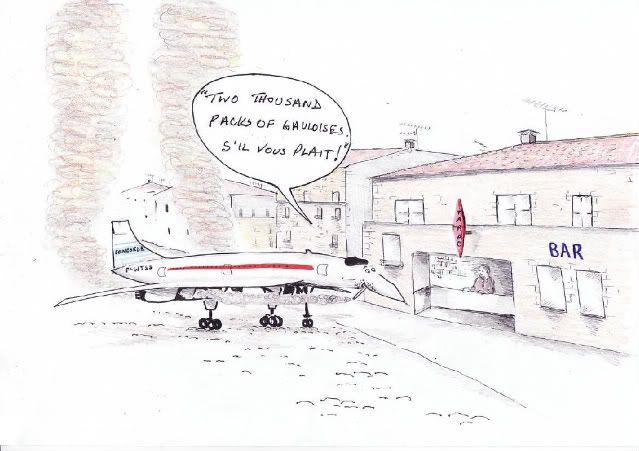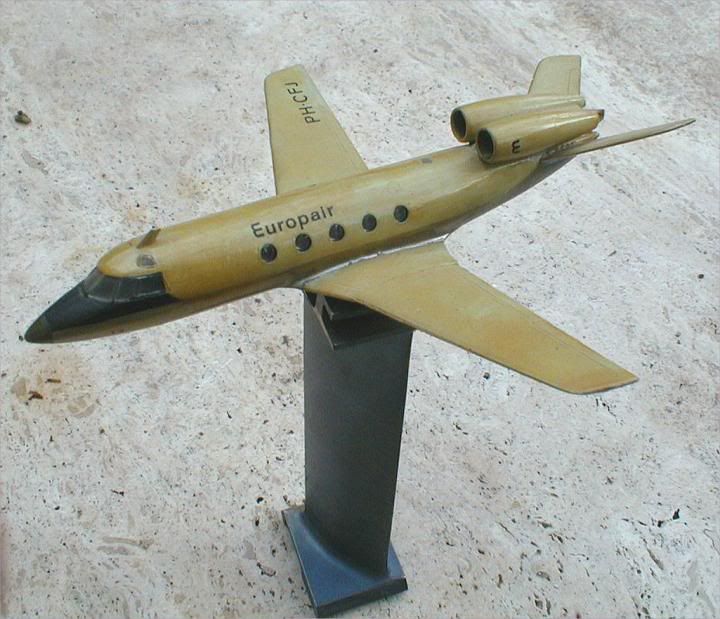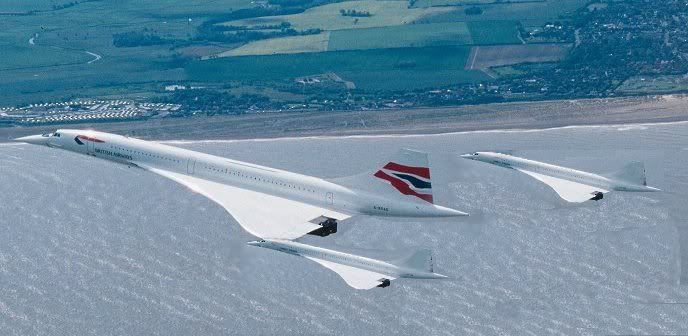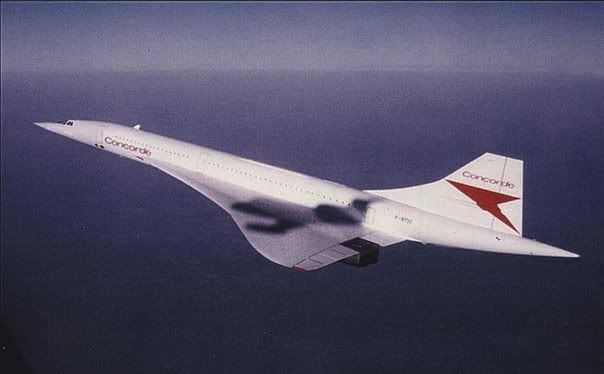November 21, 2010, 17:02:00 GMT
permalink Post: 6075823
Best glide angle for Concorde is in the order of 1:10, so with an multiple failure at 40,000ft (7.5 miles) your "nearest airport" would have to be well within a distance of 75 miles.
(BTW, I think somebody earlier already mentioned that a large part of the actual descent from top-of-descent was with the engines barely above idle, so that it was much like a glide. It was during the final hold, approach and landing, that it was preferable to have a few engines left.....)
Four-engine surges have happened a few times during flight testing, but I don't think there ever has been a four-engine flameout.
Re the SAAB Draken, I would think a dead-stick landing would be possible, but only IF you could arrive 'overhead' at about 10,000ft and IF you were well aware of the horrendous sink rate 'on the back of the drag curve' once you committed to the final approach and landing.
Even the F-104G, not known for its gliding qualities, could be and has been landed dead-stick - there is a section on the subject in the flight manual. On the 104, things were further complicated by the fact that without an engine you also lost the "blown flaps", so your landing speed was a lot higher.
In Western Europe, with its densely populated areas on the one hand, and a lot of airbases on the other hand, there were certainly cases where you thought twice before 'punching out'.
CJ
Subjects
Engine surge
Flameout
Glide
Olympus 593
Links are to this post in the relevant subject page so that this post can be seen in context.
Reply to this quoting this original post. You need to be logged in. Not available on closed threads.
November 21, 2010, 18:48:00 GMT
permalink Post: 6075980
I'm always amazed about how many people, who've never flown on Concorde, sometimes never even have seen her fly, still try to find as much about her as they can, even on technical issues they'd never bother with about for any aircraft (apart from maybe the SR-71).
It's worth passing on the heritage, I think.
CJ
Subjects
SR-71
Vortex
Links are to this post in the relevant subject page so that this post can be seen in context.
Reply to this quoting this original post. You need to be logged in. Not available on closed threads.
November 21, 2010, 20:44:00 GMT
permalink Post: 6076187
"There are no such things as stupid questions. There are only stupid answers".
So no need to apologize.
We'll do our best to answer, and do our best to keep the Concorde story 'alive'.
CJ
Subjects: None
No recorded likes for this post (could be before pprune supported 'likes').Reply to this quoting this original post. You need to be logged in. Not available on closed threads.
November 21, 2010, 22:21:00 GMT
permalink Post: 6076338
So yes, keep the questions coming, please.
We enjoy as much trying to answer them as you do asking them - maybe more...
CJ
Subjects: None
No recorded likes for this post (could be before pprune supported 'likes').Reply to this quoting this original post. You need to be logged in. Not available on closed threads.
November 24, 2010, 13:43:00 GMT
permalink Post: 6081493
M2dude may already have the details of "where", "when" and "how many" at his fingertips.
Otherwise a Google, with terms such as 'AAIB', 'DGAC', 'elevon failure' and suchlike in the query, should get you the answers.
The failures were similar to the rudder failures: part of the trailing edge of an elevon parting company with the aircraft, noticeable because of vibration, but without dire consequences.
CJ
Subjects
Elevons
Rudder
Links are to this post in the relevant subject page so that this post can be seen in context.
Reply to this quoting this original post. You need to be logged in. Not available on closed threads.
November 24, 2010, 18:55:00 GMT
permalink Post: 6082065
We ARE concerned, actually, and for the moment I don't think there is another thread on PPRuNe dealing with it.
I quote from your link:
"Mark Stewart, from Airbus, said: ....
"But the aircraft will return to its outdoor exhibition space sometime in the spring, and remain there until it moves to a new home.""
While the maintenance was indeed due, this seems to be an outright lie, so far.
After the maintenance, which will mainly consists of removing insulation that acts as a sponge for humidity, causing mould and corrosion, the aircraft is to be 'cocooned' (read: taped-off and sealed),and will be parked outside until the 'Concorde Trust' comes up with the money for a permanent museum.
Tough for the people who lost their job, deeply disheartening for the many volunteers who put their time in to show the aircraft to the public.
And a loss to us all... Alpha Fox at Filton was one of the excellent exhibits in the UK (been there, know the people concerned...).
CJ
Subjects
Airbus
Corrosion
Filton
Links are to this post in the relevant subject page so that this post can be seen in context.
Reply to this quoting this original post. You need to be logged in. Not available on closed threads.
November 25, 2010, 16:11:00 GMT
permalink Post: 6083842
The 593s on the prototypes had eight separate combustion chambers, and used fuel injectors ; the smoke resulted from the less-than-perfect combustion (as on many earlier aircraft types).
The 593s on the pre-prod and the later production aircraft had a single 'annular' combustion chamber and fuel vaporisers (the fuel entered the gas stream fully vaporised rather than as a fine spray).
While it didn't totally eliminate the smoke (as any take-off video shows...), it did make a huge difference.
It was unfortunate, that the new engines were not there in time for the prototypes, so that during the prototypes' world tours they acquired a repution of 'Smoky Joes', and gave an un-needed and undeserved boost to the tree-huggers of the time.
CJ
PS Here's another explanation....

(And no, the drawing isn't mine)
Last edited by ChristiaanJ; 25th November 2010 at 16:57 .
Subjects
Olympus 593
Links are to this post in the relevant subject page so that this post can be seen in context.
Reply to this quoting this original post. You need to be logged in. Not available on closed threads.
November 25, 2010, 16:21:00 GMT
permalink Post: 6083862
In French, it is ' un avion' (m.) and hence ' le Concorde' .... I repeatedly had to explain the use of "she" in English to French friends.
I don't think she really had a nickname within AF ; ' l'Oiseau Blanc ' (the White Bird) was/is a term more used by spotters and journos.
CJ
Subjects
Air France
Links are to this post in the relevant subject page so that this post can be seen in context.
Reply to this quoting this original post. You need to be logged in. Not available on closed threads.
November 25, 2010, 18:29:00 GMT
permalink Post: 6084093
I think it refers to setting a 'bug' for the TLA during noise reduction.
Have a google for "Concorde TLA" and poke around a bit, I think you'll find far more far sooner than I can help you with......
CJ
Subjects
TLA (Throttle Lever Angle)
Links are to this post in the relevant subject page so that this post can be seen in context.
Reply to this quoting this original post. You need to be logged in. Not available on closed threads.
November 26, 2010, 15:56:00 GMT
permalink Post: 6085970
For "Filton", read "Filton airfield and the Airbus site".
Since this is only just on the other side of Filton airfield, so far there is no question of breaking up the airframe, or road transport.
My own take is simply, that they're fed up with a Concorde on their site, that their early 'enthusiasts' who campaigned for 'A Concorde at Filton' have now left, and that it's now Airbus exerting pressure on the Concorde Trust and other bodies to provide that 'permanent home' they've been talking about for years.

As noted in another post, not the lowest, but a lot less than the 23,000+ hours of G-BOAD and G-BOAE.
In 2003, the issue with G-BOAF was that she was almost 'out of hours', with only a few hours left until the next big overhaul (an 'Inter', IIRC).
At the time, this was the reason why G-BOAF did not partake to the full extent in the flying during the last months, so as to have a few hours 'spare' for the last few flights, and of course the final flight.
Nowadays of course this is pretty irrelevant since any aircraft after seven years outside would need a 'Major' overhaul at the very least .
And that's another reason why Airbus wouldn't be bothered by those "pressures" mentioned earlier... they know perfectly well nobody is going to come up with the \xa3100M +++ to re-create the necessary infrastructure.
CJ
Subjects
Airbus
British Airways
Filton
G-BOAD
G-BOAE
G-BOAF
Galley
Links are to this post in the relevant subject page so that this post can be seen in context.
Reply to this quoting this original post. You need to be logged in. Not available on closed threads.
November 26, 2010, 17:32:00 GMT
permalink Post: 6086162
'Centrifugal acceleration' = v\xb2 / r
Speed of sound 300 m/sec, aircraft speed Mach 2 = 600 m/sec, v\xb2 = 360 000
Earth radius 6000 km = 6 000 000 m
Accel 360 000 / 6 000 000 m/sec\xb2 = 0.06 m/sec\xb2
Gravity: 1 g = 10 m/sec\xb2
So the weight loss is 0.06/10 = 0.006 = 0.6 %
So a Concorde 'en route' at 300 000 lbs would actually weigh 1800 lbs less due to this effect.
But there's another effect.....
You're flying at 18 000 m (60 000 ft), so you're 18 km further from the centre of the earth than on the ground, and gravity decreases as the square of the distance.
Again with approximate figures:
You're 6018/6000 = 1.003 further away. Ratio squared = 1.006 (or rather 1/1.006=0.994).
And there goes another 0.6 %!
Since the two effects are not related, that's 1.2 % 'weight loss'.
Obviously, the INS (inertial navigation system) 'knew' all of this... it even knew the earth isn't round.
But it might be interesting to know where else this came into play.
One example : in theory the aircraft did weigh 1.2 % less, so the lift was 1.2 % less and the drag was 1.2 % less, so the fuel consumption was less too, so did Concorde have another 50-odd miles range thrown in 'free' by flying higher and faster than it's low-down subsonic brethren?
Even a passenger weighing 165 lbs would already have lost 2 lbs, just by flying on Concorde.
But of course, that's where Landlady comes in... "champagne, caviar, anyone?"
CJ
Subjects
Cabin Crew
INS (Inertial Navigation System)
Links are to this post in the relevant subject page so that this post can be seen in context.
Reply to this quoting this original post. You need to be logged in. Not available on closed threads.
November 27, 2010, 17:18:00 GMT
permalink Post: 6087835
I remember reading a fairly detailed account of the day somewhere, either in a book or on the internet. Would you know where?
One snippet was that during the four-in-line formation, the line-up was less than perfect, and that afterwards there was a lot of good-natured ribbing among the pilots, whether n\xb0 2 should have slowed down just a tad, or whether it were n\xb0 3 and 4 who couldn't quite catch up....
IIRC, it was the same specially outfitted Lear Jet that filmed the formation, that also was used to take some of the other well-known Concorde air-to-air shots, and that was used for the filming of "Airport 79 - Concorde".
CJ
Subjects: None
No recorded likes for this post (could be before pprune supported 'likes').Reply to this quoting this original post. You need to be logged in. Not available on closed threads.
November 27, 2010, 18:30:00 GMT
permalink Post: 6087916
Not to mention the vast quantity of spare compressor and turbine blades and stator vanes, spread far and wide after the end-of-service, through the spare parts auctions.

(The model is a design that was part of my engineering studies - late '60s - but the compressor vane is real Concorde.)
M2dude and myself already have mentioned the same problem with the AICU (air intake control computer) in this thread.
People do only rarely realise how rapidly technology was changing in the early Concorde days, and how difficult it was to procure components that sometimes were already obsolete when Concorde entered service.
CJ
Subjects
AICU (Air Intake Control Computer)
Intakes
Links are to this post in the relevant subject page so that this post can be seen in context.
Reply to this quoting this original post. You need to be logged in. Not available on closed threads.
November 28, 2010, 22:52:00 GMT
permalink Post: 6089941
Ever been involved with movie making, even on the sideline?
For every minute, there's usually another thirty minutes or so of "takes".
Most of them end up straight in the bin (or the "cutting room floor", to use that ancient expression), either because they're similar but not quite as good, or because something went wrong.
Only rare samples get saved.... there's a great photo of the shadow of the Lear Jet on a Concorde, that's still around.
Still, I think there's more around than we think... I just discovered "Concorde -The World's Greatest Airliner', a DVD still on sale at the "Concorde at Filton" website, with 'stuff' I'd never seen before.
Personally, I still wonder....
"Airport 79 -Concorde" was a totally rubbishy movie.
But, in 1979, special effects and computer-generated images were still primitive, so a lot of the actual air-to-air, and in particular the low flying in the "Alps" (in reality the Pyr\xe9n\xe9es) is real, flown by French test pilot Jean Franchi.
One of the scenes in the film involves a looping (!) to evade a missile.
Franchi suggested to replace this with a barrel roll , which he'd already performed repeatedly with a Concorde.
Sadly, his suggestion wasn't taken up by the producer, and the movie still has the improbable "loop-the-loop".
But, the question will remain forever....
Did Jean Franchi ever perform one of his barrel rolls in front of the Lear Jet, to show what it would look like?
And is any of that footage still stored somewhere?
I still dream....
CJ
Subjects
Filton
Links are to this post in the relevant subject page so that this post can be seen in context.
Reply to this quoting this original post. You need to be logged in. Not available on closed threads.
November 29, 2010, 17:08:00 GMT
permalink Post: 6091297
CJ
Subjects: None
No recorded likes for this post (could be before pprune supported 'likes').Reply to this quoting this original post. You need to be logged in. Not available on closed threads.
November 29, 2010, 20:29:00 GMT
permalink Post: 6091604
I've seen that too, but Wiki doesn't make it clear whether that figure includes the prototype and preprod engines, or only the final MK 610 engines.
CJ
Subjects: None
No recorded likes for this post (could be before pprune supported 'likes').Reply to this quoting this original post. You need to be logged in. Not available on closed threads.
November 29, 2010, 21:36:00 GMT
permalink Post: 6091728
Some of it can now be told.....
From the secret archives.

CJ
Subjects
Air France
Links are to this post in the relevant subject page so that this post can be seen in context.
Reply to this quoting this original post. You need to be logged in. Not available on closed threads.
November 29, 2010, 21:41:00 GMT
permalink Post: 6091743
Subjects: None
No recorded likes for this post (could be before pprune supported 'likes').Reply to this quoting this original post. You need to be logged in. Not available on closed threads.
December 03, 2010, 18:22:00 GMT
permalink Post: 6100356
Concorde wasn't created 'ab nihilo', in a vacuum, as it were.
So, placing her squarely in the aviation world of the time should be part of the thread and the story.
In my own field (avionics) both TSR-2 and Concorde are almost "snapshots" of technology at a given time, a technology which was changing very rapidly.
I may go and rabbit on about that some more, one of these days, but describing what happened in the avioncs/electronics field is always more difficult than the purely mechanical, engine and structure progress.
CJ
PS A few years ago I had a chance to have a close look at some of the TSR-2 electronics in the East Fortune (Scotland) museum.
IIRC a lot of it was Ferranti.
It was an eye-opener as to how much technology had already changed from TSR-2 to Concorde.
Subjects
Afterburner/Re-heat
Avionics
Rolls Royce
Links are to this post in the relevant subject page so that this post can be seen in context.
Reply to this quoting this original post. You need to be logged in. Not available on closed threads.
December 09, 2010, 17:09:00 GMT
permalink Post: 6112640
Welcome!
Your question has been answered in detail, but a bit beyond page 9.. read on and enjoy.
CJ
Subjects: None
No recorded likes for this post (could be before pprune supported 'likes').Reply to this quoting this original post. You need to be logged in. Not available on closed threads.
 were there any failures during her time in the skies ?
were there any failures during her time in the skies ?
